Introduction to Mayon Volcano
Mayon Volcano is a well-known symbol of the Philippines’ natural beauty and geological activity. It serves as a scenic backdrop to Albay Province and stands as an example of the raw power of nature.
As I flew into Legazpi, the first thing that caught my eye was the breathtaking sight of Mayon volcano emerging from the reddish clouds. It was early morning, and the view was simply stunning. Everywhere I looked in Legazpi and nearby towns, there she was, Mayon, standing tall and majestic.
It felt like she was playing a game of hide and seek throughout the day, but whenever she revealed herself, it was an awe-inspiring moment. And let me tell you, the experience was even more exhilarating when I explored the area on a quad bike. Mayon’s beauty truly makes it the star of the region.
Table of Contents
Geographical Location
Mayon Volcano is situated in the Bicol Region of the Philippines, specifically within Albay Province on Luzon Island. It’s located 10 kilometers away from the Albay Gulf, offering a breathtaking view that stands out across the scenery.
The cities and municipalities around the volcano include Legazpi, Daraga, Camalig, Guinobatan, and Ligao.
Historical Significance
As one of the most active stratovolcanoes in the world and part of the Pacific Ring of Fire, Mayon Volcano has a rich recorded history of eruptions dating back to 1616.
Its most catastrophic eruption occurred in 1814, claiming over 1,200 lives and causing significant damage to surrounding towns.
Physical Characteristics
Mayon Volcano is renowned for its near-perfect cone shape, a result of layers of lava and other volcanic materials.
Standing at 2,463 meters (8,081 ft), it has steep upper slopes with an average angle between 35 to 40 degrees, culminating in a small summit crater.
Mayon has had approximately 50 eruptions in the last few centuries, emphasizing its status as an active volcano.
Volcanic Activity of Mayon
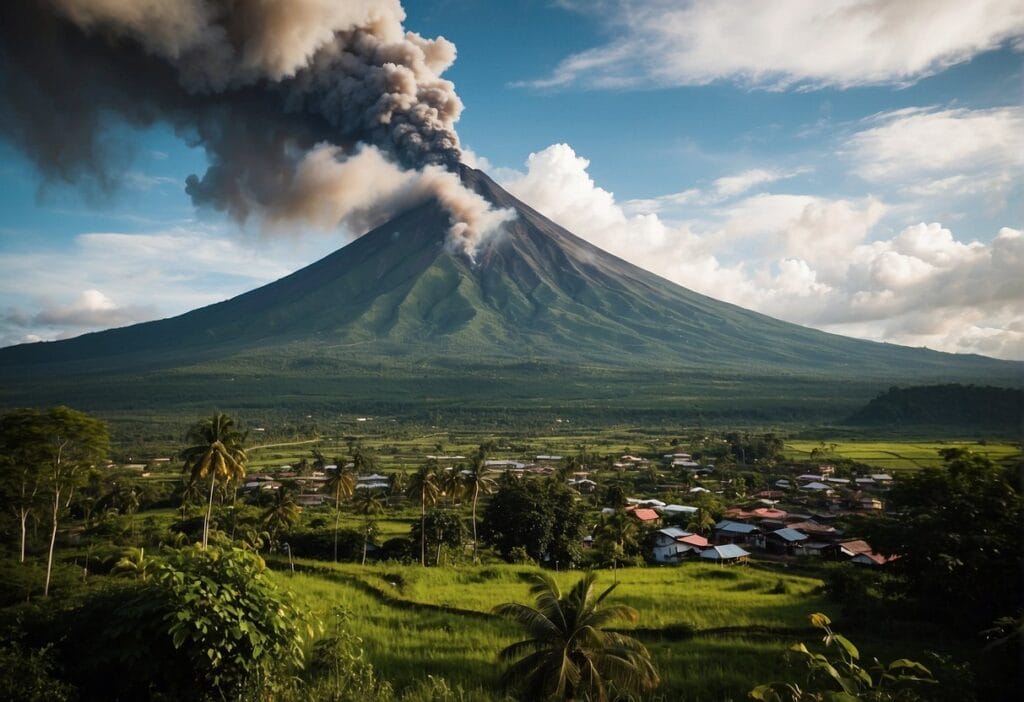
Mayon Volcano, prominent for its near-perfect cone shape, stands as the most active volcano in the Philippines with a legacy of frequent and diverse eruptions.
Eruption History
Mayon Volcano has a long history of eruptive episodes, ranging from quiet lava flows to violent explosive events. Historical records date back to its first documented eruption in 1616.
Since then, it has erupted over 50 times, with varying intensities and impacts on the surrounding communities and environment.
Monitoring and Alert Levels
The Philippine Institute of Volcanology and Seismology (PHIVOLCS) actively monitors Mayon’s activity. They use a standardized Alert Level system to communicate the status of the volcano:
- Alert Level 0: No eruption imminent
- Alert Level 1: Low level of seismicity, slight inflation or deflation of the volcano, weak steam emission
- Alert Level 2: Moderate level of seismicity, possible magmatic intrusion which could eventually lead to an eruption
- Alert Level 3: Relatively high unrest, magma is near or at the crater and hazardous eruption is possible within weeks
- Alert Level 4: Intense unrest, hazardous eruption is possible within days
- Alert Level 5: Hazardous eruption is underway
This system helps authorities and residents prepare for possible evacuations and take necessary precautions.
Recent Eruptions and Impacts
A significant eruptive period started in January 2018, causing thousands of nearby residents to evacuate.
Following this, in June 2023, increased volcanic activity included lava spewing and emission of sulfur dioxide, indicating magma was moving beneath the volcano.
As a result, Alert Level 3 was raised, warning of a potential hazardous eruption.
This prompted PHIVOLCS to advise local communities of the risks posed by pyroclastic density currents, volcanic earthquakes, and ashfall.
Mandatory evacuations were ordered within a set distance, greatly affecting the mostly farming areas surrounding Mayon.
Hazards and Safety Measures
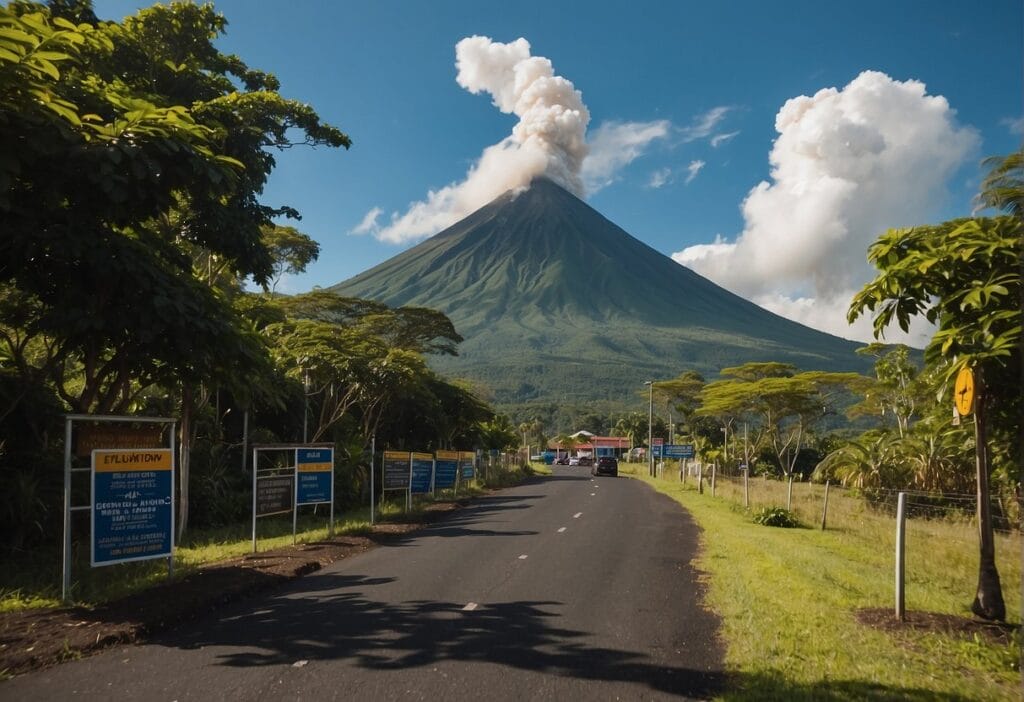
Mayon Volcano in Albay Province is an active stratovolcano with a history of dangerous eruptions.
The local government, in collaboration with scientific agencies, has established measures to mitigate risks and ensure public safety in the face of natural volcanic activities.
Danger Zones and Evacuation
The Permanent Danger Zone (PDZ) surrounding Mayon Volcano extends to a 6-kilometer radius from the summit, where entry is strictly prohibited.
Elevated alert levels can lead to the expansion of this zone, necessitating proactive evacuations.
Evacuation protocols are activated based on the active alert level, with the aim of moving residents to safer areas before more hazardous activities such as eruptions occur.
- Alert Level 3: Suggestive of an increased tendency towards a hazardous eruption.
- Alert Level 2: Indicates a decrease in unrest, but the potential for eruption remains.
Volcanic Hazards
Mayon Volcano presents multiple volcanic hazards:
- Pyroclastic flows: Hot gas and volcanic matter that can race down the slopes.
- Lahars: Volcanic mudflows triggered by heavy rainfall mixing with volcanic ash.
- Sulfur dioxide emissions: Can cause respiratory problems and environmental damage.
These hazards require constant monitoring to provide timely warnings for necessary actions, including establishing no-entry zones.
Government Preparedness and Response
The government operates through set protocols for natural disasters such as volcanic eruptions.
PHIVOLCS, the Philippine Institute of Volcanology and Seismology, plays a crucial role in monitoring the volcano’s activity and issuing alerts.
Their responsibilities extend to generating hazard maps for pyroclastic flows and lahars, facilitating informed evacuations and government response strategies.
Government response measures focus on:
- Establishing evacuation centers: Readily available safe havens for displaced residents.
- Educating the public: Regular information campaigns on volcanic risks and safety protocols.
- Infrastructure resilience: Strengthening buildings and roads to withstand lahars and mudslides.
Ecosystem and Biodiversity
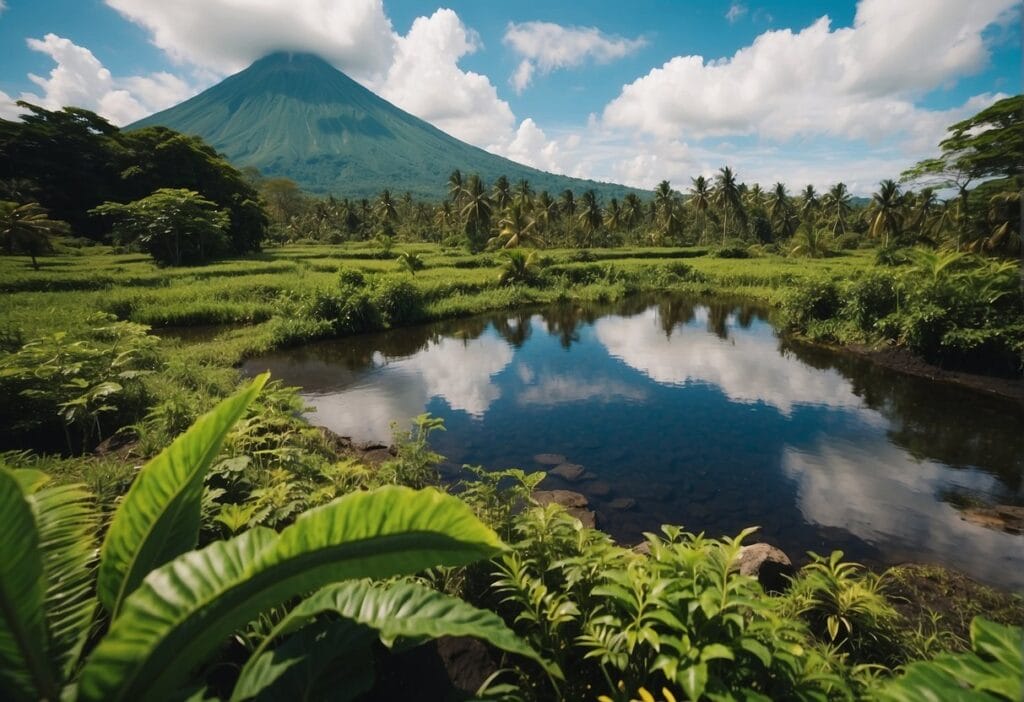
Mayon Volcano in Albay, Philippines, is not only known for its near-perfect cone shape, but also for its rich ecosystem and biodiversity.
Anchored within the Albay Gulf’s area, the environment around the volcano supports a wide range of life forms amidst periodic lava flows and eruptions.
As I flew into Legazpi, the first thing that caught my eye was the breathtaking sight of Mayon volcano emerging from the reddish clouds. It was early morning, and the view was simply stunning. Everywhere I looked in Legazpi and nearby towns, there she was, Mayon, standing tall and majestic.
It felt like she was playing a game of hide and seek throughout the day, but whenever she revealed herself, it was an awe-inspiring moment. And let me tell you, the experience was even more exhilarating when I explored the area on a quad bike. Mayon’s beauty truly makes it the star of the region.
Flora and Fauna
Flora: Mayon Volcano and its surrounding areas are host to a remarkable diversity of plant species.
A notable presence includes various endemic and indigenous woody species, recorded across different genera and families.
The vegetation patterns vary significantly as one moves from the base to higher altitudes, adapting to the changing conditions influenced by volcanic activity.
- Endemic species: Approximately 32% of the recorded woody plant species are endemic to the region, showcasing the unique character of the biosphere.
- Indigenous species: They form a sizable portion of the flora, contributing to the balanced ecosystem present around Mayon.
Fauna: The fauna around Mayon Volcano is as varied as its plant life.
Despite the perceived harshness of the volcanic landscape, a variety of animal species have adapted to the environment, including a number of bird species, reptiles, and mammals.
Environmental Monitoring
Provincial Environment and Natural Resources Office (PENRO) Albay: Their Biodiversity Monitoring System (BMS) plays a crucial role in assessing the health and diversity of ecosystems within the biosphere reserve.
PENRO Albay conducts regular monitoring, which is essential in understanding the impacts of volcanic activity on the area’s biodiversity and in formulating conservation strategies.
- BMS Findings: Studies and observations from the BMS contribute valuable insight into how flora and fauna adapt and survive following episodes of eruptions and lava flows, particularly in areas like Legazpi City, which lie in proximity to the volcano.
- Habitat Recovery: Post-eruption regrowth is an important aspect observed by the BMS, demonstrating the resilience of the natural ecosystems and their capability to recover from volcanic disturbances, thus sustaining life even after significant ecological events.
Cultural and Economic Impact
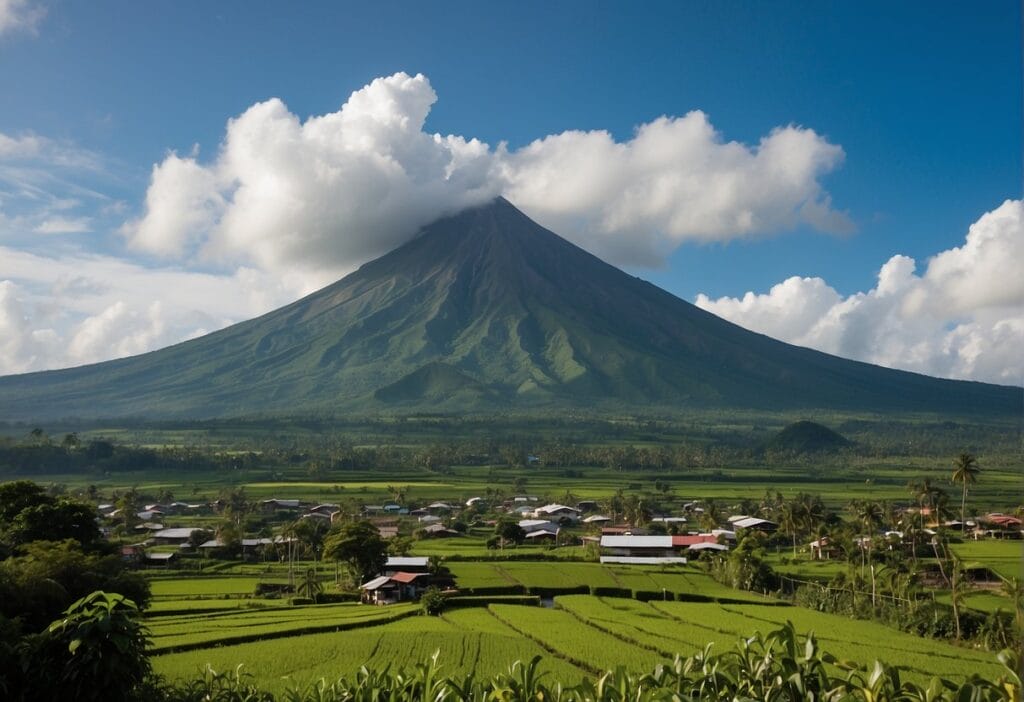
Mayon Volcano in Albay is a significant cultural symbol and economic engine for the region. Its contributions span from tourism and agriculture to preservation of cultural heritage.
Tourism at Mayon Volcano
Mayon Volcano is a key tourist attraction in Albay, drawing visitors from around the globe to witness its near-perfect cone shape.
The presence of the volcano has spurred tourism development in nearby cities such as Legazpi and Tabaco City, where hotels, restaurants, and tourism services have proliferated.
The influx of tourists supports local businesses and creates numerous job opportunities within Albay Province.
- Key Tourist Sites:
- Cagsawa Ruins: The remnants of a 16th-century church buried by Mayon’s 1814 eruption.
- Lava Trails: Guided tours for visitors to explore the paths of previous lava flows.
Agriculture and Livelihoods
The fertile soils surrounding Mayon Volcano, enriched by volcanic minerals, are ideal for agriculture, supporting the livelihoods of communities in Daraga, Camalig, and Guinobatan.
Farmers in these areas cultivate rice, vegetables, and the famed Bicolano chili. However, the threat of eruptions can disrupt this economic mainstay through destruction of crops and farmland, demonstrating a delicate balance between the benefits and risks of living near an active volcano.
Cultural Heritage Sites
Mayon Volcano is deeply woven into the fabric of cultural identity in Southeast Asia, particularly for the communities that have settled in its shadow.
- Daraga Church, also known as Our Lady of the Gate, offers a prime example of religious architecture influenced by the volcano’s historical eruptions.
- Legazpi City and Tabaco City are custodians of history, with numerous landmarks and museums that recount tales of their resilience and adaptability in the face of volcanic activity.
Scientific Research and Education
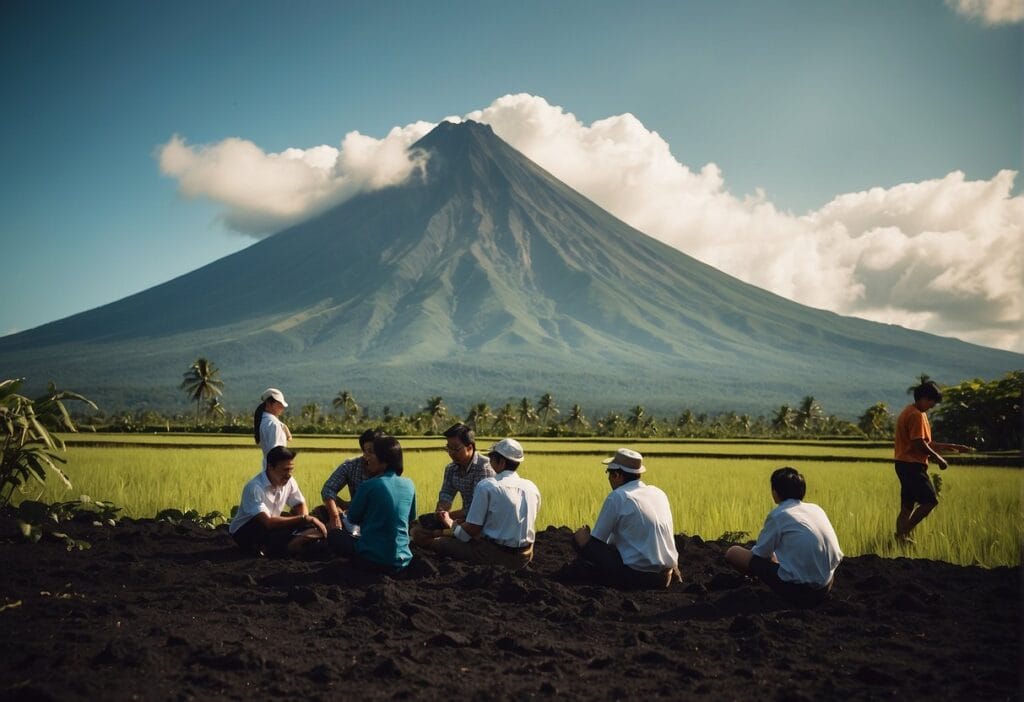
Mayon Volcano is the subject of extensive volcanological studies due to its active nature. The educational initiatives in the region are targeted to enhance awareness and preparedness.
Volcanological Studies
The Philippine Institute of Volcanology and Seismology (PHIVOLCS) actively monitors Mayon Volcano. The volcano is recognized for its almost perfectly symmetrical volcanic cone—an outstanding example of a stratovolcano.
The main focus of research includes the monitoring of seismic activity, rockfall events, and the precise measurement of volcanic gas emissions. The volcano’s activity is closely linked to its position on a subduction zone, where the tectonic plates interact to generate magmatic processes.
Scientists conduct field studies to analyze changes in the volcano’s shape, which can indicate rising magma and potential eruption events.
Educational Initiatives
Educational programs are an important tool for communities living near Mayon Volcano. PHIVOLCS and local educational institutions collaborate to spread awareness about the risks and safety practices associated with living in proximity to an active volcano.
Earthquakes and rockfall events are significant concerns, leading to the development of educational materials that address these topics.
Schools and community groups use tailored curricula to promote understanding of volcanic hazards, fostering a culture of safety and preparedness among residents and visitors.
Frequently Asked Questions
This section aims to address common inquiries regarding Mayon Volcano’s history, activity, and allure as a natural landmark.
What is the history of Mayon Volcano in Albay?
Mayon Volcano, known for its perfectly shaped cone, has a long history connected to Albay Province’s culture. Legends say it got its name from the lovely princess Daragang Magayon.
What is the most recent eruption of Mayon Volcano?
The most recent eruption of Mayon Volcano occurred in January 2018, when it spewed ash and lava, prompting thousands of residents to evacuate the surrounding areas.
What are some notable facts about Mayon Volcano?
Standing at 2,462 meters, Mayon Volcano is renowned for its nearly perfect cone shape. It is visible from various cities and towns in Albay and has erupted over 50 times in historical records.
Why is Mayon Volcano considered one of the most active volcanoes?
Mayon is considered one of the most active volcanoes because of its frequency of activity. It has had over 50 recorded eruptions, due to its position on the Pacific Ring of Fire where tectonic plates interact vigorously.
What makes Mayon Volcano a significant tourist attraction?
Its iconic perfect cone, which is rare for a stratovolcano, and the scenic landscape surrounding it make Mayon a significant tourist attraction in the region. The Cagsawa Ruins are particularly famous for their view of the volcano.
How often does Mayon Volcano erupt?
Mayon Volcano has erupted over 52 times in the last 500 years. This indicates a pattern of eruption roughly once per decade, although the intervals between eruptions have varied.
